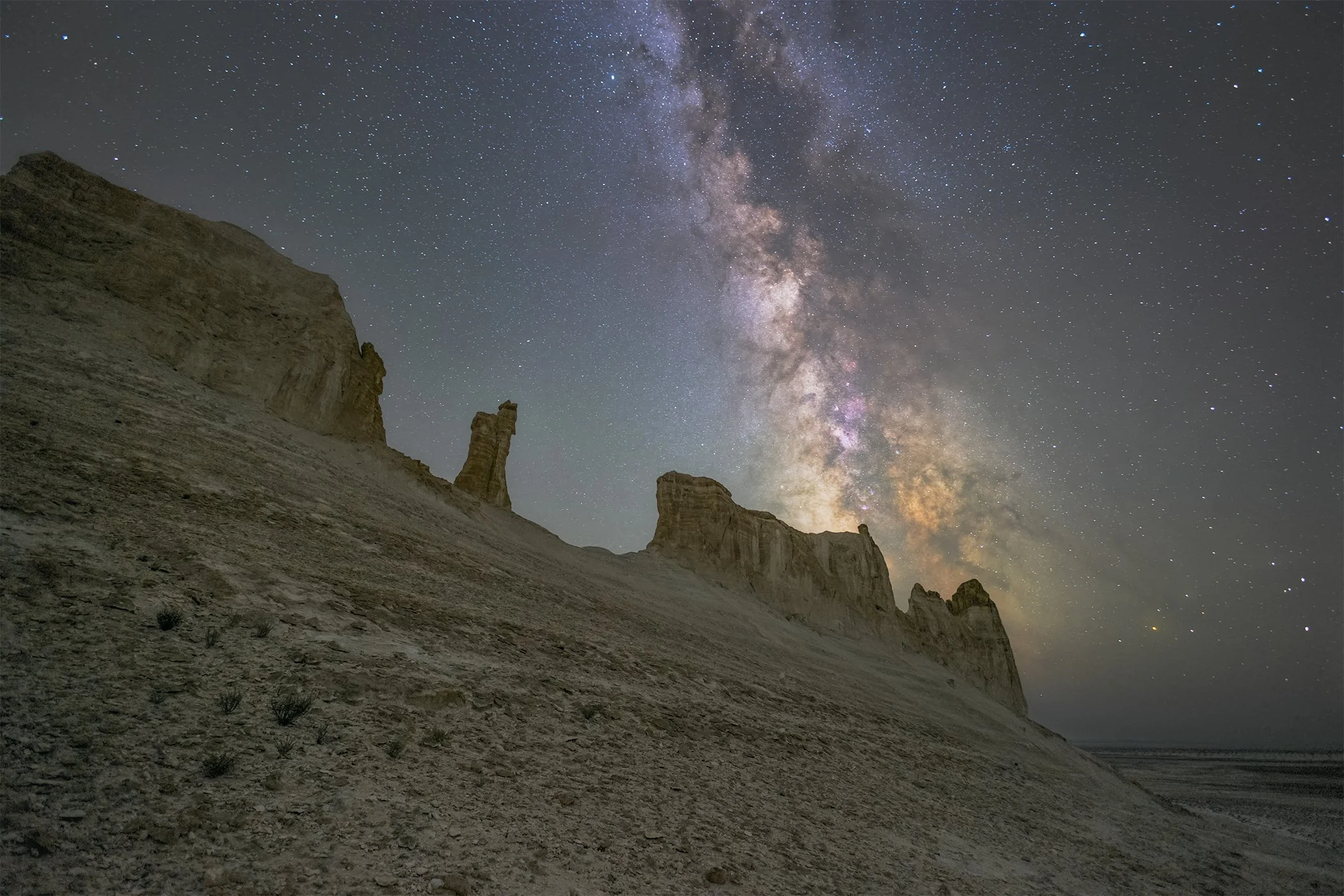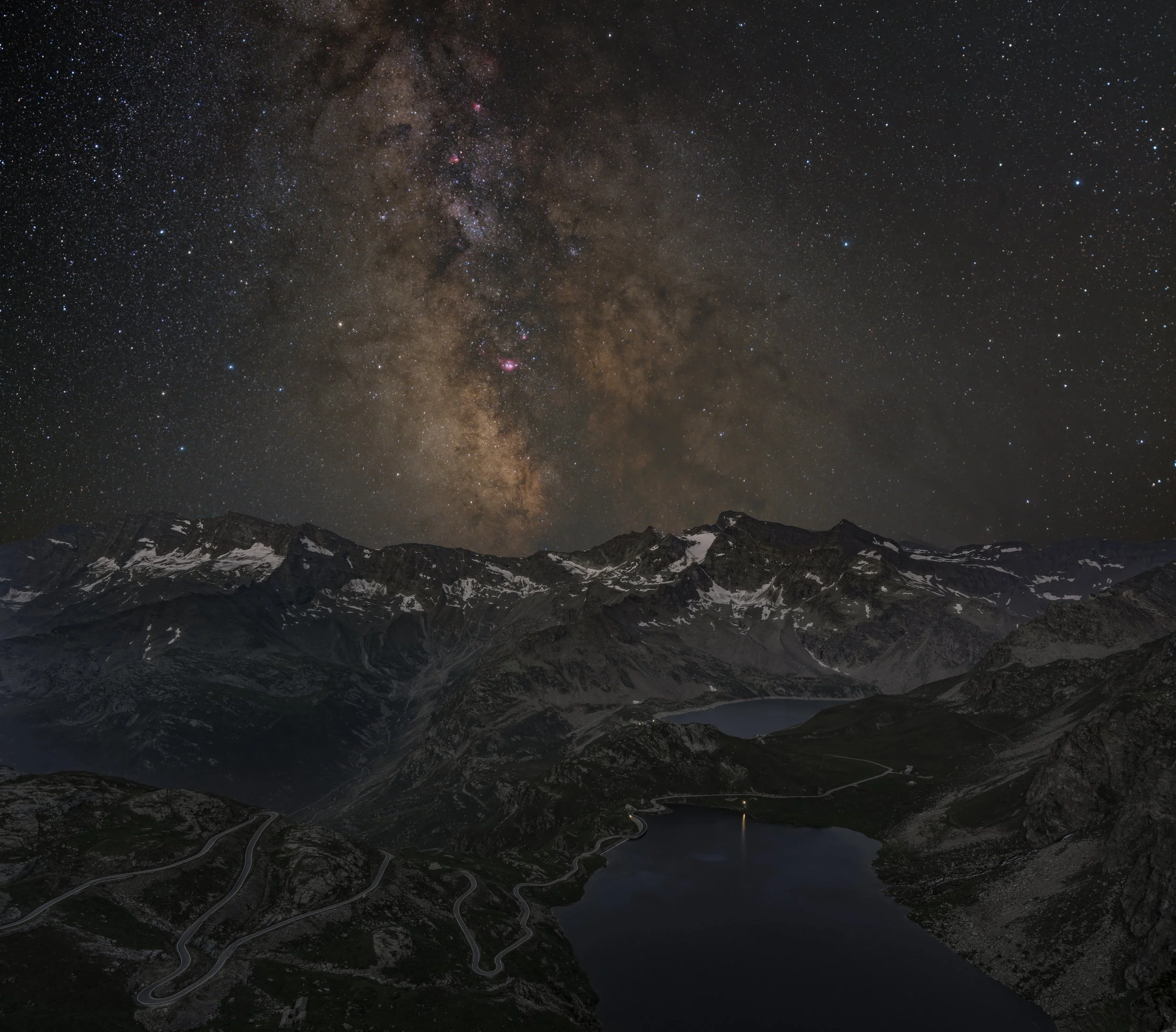
AAPOD2 Image Archives
A deep look at the Milky Way Core HaRGB Mosaic
A breathtaking high-resolution mosaic reveals the glowing heart of our galaxy, the Milky Way. Captured through a 135mm HaRGB setup, the image highlights a complex web of ionized hydrogen gas (shown in red), dark dust lanes, and star-forming regions. The galactic core, rich in emission nebulae and dense molecular clouds, sits shrouded in interstellar dust that obscures visible light but glows brilliantly in this composite view.
Stretching across the field, the image captures the interplay between dark and luminous regions, offering a sense of the immense scale and structure of the Milky Way’s inner spiral arms. This deep and carefully assembled mosaic brings the hidden beauty of the galactic center into sharp focus, revealing both the chaos and order at the core of our home galaxy.
Milky Way Over Aktau Mangystau Kazakhstan
The brilliant core of the Milky Way rises above the dramatic white cliffs of Aktau in Mangystau, Kazakhstan. The star clouds and dark dust lanes of our galaxy stretch high into the sky, revealing bright star-forming regions and glowing nebulae near the Galactic Center. The rocky foreground, softly lit by starlight, provides a stunning contrast to the vibrant celestial panorama above.
This image was created by stacking 20 light frames and 10 dark frames, captured with a Canon R6 to reduce noise and enhance faint detail. The result is a crisp and colorful view of the Milky Way’s central bulge from one of Kazakhstan’s most remote and otherworldly landscapes.
Milky Way on Nivolet
Under the pristine skies of Nivolet, the Milky Way unfurls its resplendent splendor in this captivating landscape image. Nivolet, known for its pristine natural beauty, provides an ideal backdrop for gazing into the cosmic abyss. In this enchanting photograph, the luminous band of our galaxy stretches majestically across the night sky, casting a gentle glow upon the serene landscape below.
As the Milky Way's countless stars twinkle overhead, they reflect in the tranquil waters of Nivolet, creating a mesmerizing mirror effect that blurs the boundary between Earth and the cosmos. The surrounding landscape, bathed in the soft light of the night, adds to the enchantment, highlighting the harmony between the earthly and the celestial. This image is a testament to the timeless beauty and wonder that awaits those who venture into the heart of nature to witness the grandeur of the Milky Way above Nivolet.
Two Milky Ways
Image Description:
I have updated my large mosaic of the Milky Way with the high resolution imaging I did in 2021. The upper image is taken through H-alpha, SII and OIII filters and the lower one through HaRGB. All the major nebulosity is now taken at a focal length of 530mm. This gives the image very crisp detail when viewed as a whole. Other images around the major nebulosity were taken at focal lengths of 85mm and 14mm. This mosaic has a total of 216 panels and over 2200 hours of imaging time. It uses data taken over the last 3 years which is why in the HaRGB image Jupiter (which looks like a very bright star) is above Sagittarius and in the SHO image which I took 12 months later it is below. That's how far it moved in a year.
Equipment Used
Telescope Canon 35mm L Series Lens, Sigma 85mm Lens, Takahashi TOA-130/FSQ 106 (Detail for the Nebulae)
Camera STL-11000M/STXL-11002M (Detail of the Nebulae) and SBIG STF-8300 and Canon 6D DSLR for the Widefield
216 image Mosaic with ~2268 hours of imaging through RGB. H-alpha, SII and OIII filters.
Copyright: Alistair Symon
Queyras lake over the Milky Way
Image Description and Details :
I've been trying to do this photograph for a little over a year. Nearly 11km walk to one of these lakes with food, bivouacing and photo gear on the back. In my last 2 tests, the sky managed to cover for the whole night. Being at an altitude of about 2400m, the lake offers a negative temperature during the summer nights; needless to tell you it does... Cold! Especially since the humidity is high then increasing the feeling of the cold. The night of September 5-6 was cleared at the beginning before the arrival of a cloudy passage that did not last long. Phew! Unfortunately, the sky began to rediscover itself when the Moon rose. Its light was still strong enough to dazzle the starry sky. This lake is located at the border between France and Italy.This photo is panoramic view composed of 9 photos taken with a Canon 5D MKIII + lens Samyng f/1.4 (@f/2.8) on tripod.The the foreground was photographed a little before dark night. For the Milky Way, I waited for the dark night to start photography it. Place : Saint-Véran (Hautes-Alpes / France).
Copyright Information: Jeff Graphy
Moonset under the Milky Way
The Observatory of Saint-Veran (French: Observatoire de Saint-Véran) is a French astronomical observatory located on the Pic de Château Renard in the municipality of Saint-Véran in the department of Hautes-Alpes in the French Alpes. At 2,930 meter altitude, it is one of the highest observatories in Europe.
The Observatory is managed by the French amateur astronomy association and was built in 1974 as a branch of the Paris Observatory.
Southern Milky Way
Mount SkyWatcher Star Adventurer.
Digital Camera Canon 60 Da
Lenses Tamron SP 17-50 mm F/2.8 at 50/2.8
Total exposure: 44’ with integration of n. 19 image
Guider: QHY5L-II-M and Mini Borg ED 45
Adquisition: MaximDL
Imaging Processing by Attilio Bruzzone with PixInsight
Copyright: Antonio Ferretti (Photo Acquisition) from Papamoa (New Zealand) and Attilio Bruzzone (Imaging Processing).







